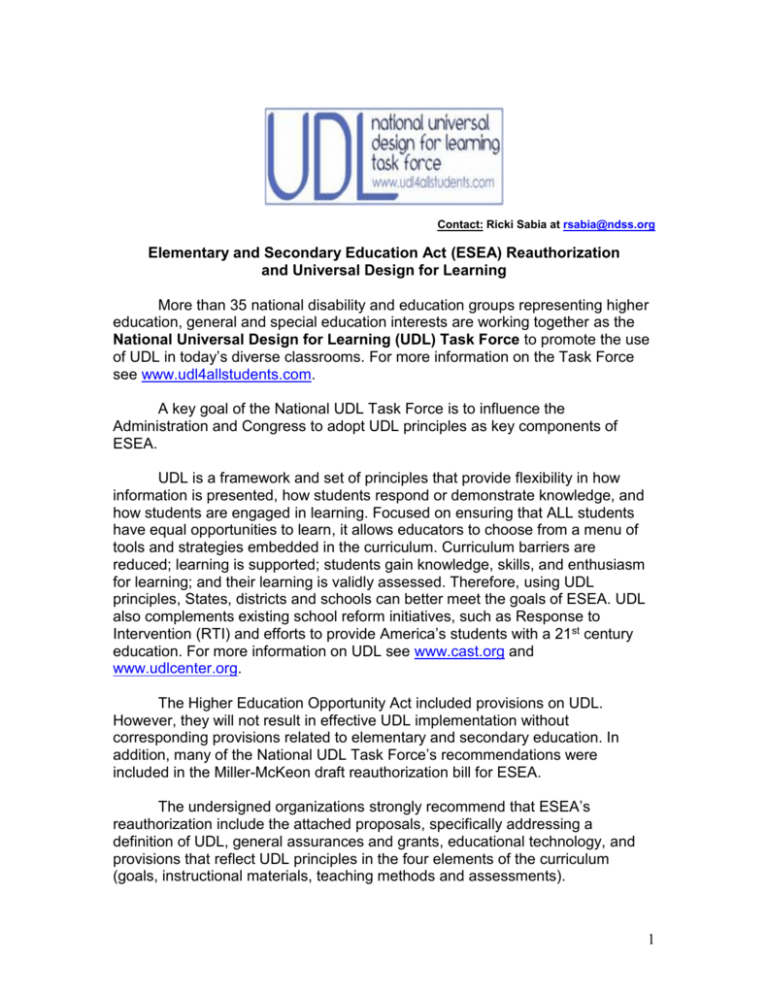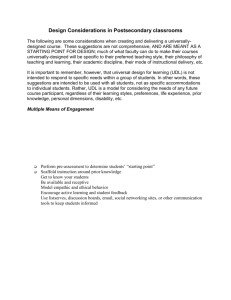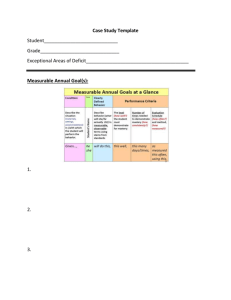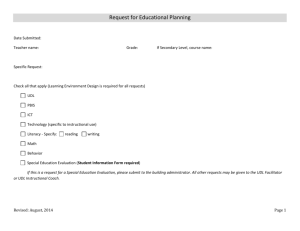Word - National Center On Universal Design for Learning
advertisement

Contact: Ricki Sabia at rsabia@ndss.org Elementary and Secondary Education Act (ESEA) Reauthorization and Universal Design for Learning More than 35 national disability and education groups representing higher education, general and special education interests are working together as the National Universal Design for Learning (UDL) Task Force to promote the use of UDL in today’s diverse classrooms. For more information on the Task Force see www.udl4allstudents.com. A key goal of the National UDL Task Force is to influence the Administration and Congress to adopt UDL principles as key components of ESEA. UDL is a framework and set of principles that provide flexibility in how information is presented, how students respond or demonstrate knowledge, and how students are engaged in learning. Focused on ensuring that ALL students have equal opportunities to learn, it allows educators to choose from a menu of tools and strategies embedded in the curriculum. Curriculum barriers are reduced; learning is supported; students gain knowledge, skills, and enthusiasm for learning; and their learning is validly assessed. Therefore, using UDL principles, States, districts and schools can better meet the goals of ESEA. UDL also complements existing school reform initiatives, such as Response to Intervention (RTI) and efforts to provide America’s students with a 21st century education. For more information on UDL see www.cast.org and www.udlcenter.org. The Higher Education Opportunity Act included provisions on UDL. However, they will not result in effective UDL implementation without corresponding provisions related to elementary and secondary education. In addition, many of the National UDL Task Force’s recommendations were included in the Miller-McKeon draft reauthorization bill for ESEA. The undersigned organizations strongly recommend that ESEA’s reauthorization include the attached proposals, specifically addressing a definition of UDL, general assurances and grants, educational technology, and provisions that reflect UDL principles in the four elements of the curriculum (goals, instructional materials, teaching methods and assessments). 1 The National UDL Task Force appreciates your consideration of these recommendations. Please contact Ricki Sabia at rsabia@ndss.org if the Task Force members can be of assistance or if you have any questions. American Association of Colleges for Teacher Education American Federation of School Administrators American Federation of Teachers American Institutes for Research American Occupational Therapy Association Association of Teacher Educators American School Counselor Association American Speech-Language-Hearing Association Association of Assistive Technology Act Programs Association of Teacher Educators Autistic Self-Advocacy Network Council of Administrators of Special Education, Inc. Council for Exceptional Children Easter Seals Higher Education Consortium for Special Education Institute for Educational Leadership Learning Disabilities Association of America National Association of School Psychologists National Association of Secondary School Principals National Association of State Directors of Special Education National Center for Learning Disabilities National Down Syndrome Association National Down Syndrome Congress National Education Association National School Boards Association School Social Work Association of America TASH Teacher Education Division of the Council for Exceptional Children The Advocacy Institute The Arc of the United States United Cerebral Palsy Vocational Evaluation and Career Assessment Professionals Association VSA American Association on Intellectual & Developmental Disabilities Association of University Centers on Disabilities Center for Law and Education Children and Adults with Attention-Deficit/Hyperactivity Disorder Our Children Left Behind Respect ABILITY Law Center 2 National UDL Task Force Recommendations for ESEA Reauthorization Definition The term universal design for learning from Section 103(a)(24) of the Higher Education Opportunity Act of 2008 reads as follows and should be incorporated in ESEA: UNIVERSAL DESIGN FOR LEARNING.--The term `universal design for learning' means a scientifically valid framework for guiding educational practice that-``(A) provides flexibility in the ways information is presented, in the ways students respond or demonstrate knowledge and skills, and in the ways students are engaged; and ``(B) reduces barriers in instruction, provides appropriate accommodations, supports, and challenges, and maintains high achievement expectations for all students, including students with disabilities and students who are limited English proficient.''. General Provisions The State should give assurances that the state educational agency (SEA), in consultation with experts, teachers and other stakeholders in universal design for learning, will develop a comprehensive plan to address the implementation of universal design for learning. The SEA and LEA should provide assurances that they will encourage the use of curricular goals, teaching methods, instructional materials and assessments that are consistent with the principles of universal design for learning. Funds used by LEAs from any grants to develop curriculum, provide essential materials and textbooks, provide staff development and/or create and use formative assessments should do so in a manner that supports the principles of universal design for learning. Establish a federal competitive grant program to transform existing practices to reflect the UDL framework in the following areas: standards, instructional methods, curriculum, accountability/assessment systems, and professional development beginning with a needs assessment and including evaluation and national dissemination of what works. 3 Advance the UDL framework as an allowable use of all existing federal funding directed at improving education: pr-K, K-12, and postsecondary. Educational Technology Funding from grants for educational technology should be used to: permit the purchase and implementation of universally designed technology, including staff development and technical support; to ensure that all students, including those with disabilities, will have an opportunity to benefit from the integration of technology into the general education curriculum; and provide students with frequent opportunities during instruction to use the universally designed technologies that may be applied to large scale assessments and to measure the impact of universally designed technologies on the learning and achievement of all learners. Universally designed technology should be defined as hardware and software that: include the features necessary for use by all learners or support integration with the necessary assistive hardware and software technologies to ensure that they are accessible and optimized for all learners; and provide flexibility in the ways that information is presented, in the ways that students respond or demonstrate knowledge, and in the ways in which students are engaged in order to provide appropriate support and challenge and enhance the performance for a typically diverse spectrum of learners. Curricular Goals Each ESEA state plan should demonstrate that the state has adopted challenging academic content standards and challenging student academic achievement standards that are consistent with the principles of universal design for learning, or will adopt such standards as soon as feasible. There should be assurances that the SEA will assist the LEA and the LEA will assist the schools in developing or identifying high-quality effective curricula that are rigorously aligned with State academic achievement standards and are accessible to students with disabilities and English language learners through the use of universal design for learning, to the maximum extent practicable. 4 Instructional Materials The LEA and/or SEA, depending on which entity is responsible for the selection of textbooks and other instructional materials, should encourage the purchase of textbooks and materials that are consistent with the principles of universal design for learning. Teaching Methods In grants for preparing, training, and recruiting high quality teachers and specialized instructional support personnel, the application should require a description of how the SEA will use the funds to provide training in the use of teaching methods consistent with the principles of universal design for learning. These trainings should be carried out using UDL methods. Also the needs assessments should be conducted with the involvement of both general and special education teachers and specialized instructional support personnel and take into account activities that need to be conducted to provide educators with teaching skills consistent with the principles of universal design for learning. Assessments Assessments should be required to be universally designed, to the extent feasible. To clarify the standard for universally designed assessments, the definition should state: These assessments are developed using the principles of universal design for learning in order to minimize the effect of construct-irrelevant factors—such as physical, sensory, learning, or cognitive disabilities, or language barriers—that may interfere with the accuracy of the assessment; and provide appropriate supports for students to demonstrate the knowledge, skills, and abilities according to the intended learning standards. To encourage the development of universally designed assessments, grants made by the Secretary to enable States to pay for the development of assessments and standards under the Act should require that these assessments and standards incorporate the principles of universal design for learning. 5




